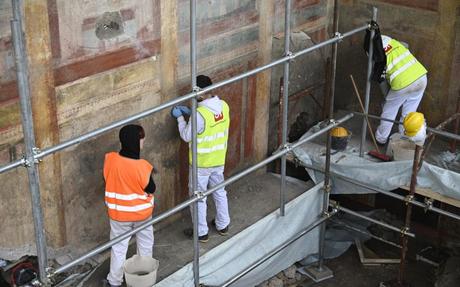
Tomb Raiders once dug through layers of ash and pumice, ruthlessly searching for ancient treasures by the light of candles.
Now, centuries later, archaeologists have uncovered the tunnels used by the early explorers of the Roman city of Pompeii, which were preserved under a suffocating blanket of volcanic debris when Mount Vesuvius erupted in 79 AD. erupted. And they have warned that the ancient site remains under threat from treasure hunters.
The tunnels, which were dug through walls decorated with beautiful paintings, were dug by workers on behalf of the Spanish Bourbon dynasty, the rulers of Naples in the 18th and 19th centuries.
They were discovered in a huge Roman villa that recently came to light in a newly excavated part of the city on the Bay of Naples.
From 1748 until the 19th century, tunnellers dug vertical shafts into the ground and from there they dug through the remains of the old city, which were buried under volcanic ash and pumice during the volcano's eruption.
They met the demands of the Bourbons, who developed a passion for finding ancient Roman treasures and displaying them in their palatial homes.
'They looked like moles'
"They looked like moles," says Alessandro Russo, one of the architects who recently discovered the tunnels. "They dug a whole labyrinth of galleries. They were very narrow and would have been lit only by open flames of candles. There was a risk that the tunnels would collapse. It would have been dangerous work."
One of the newly found tunnels dug through a palatial reception room that was only recently excavated by Pompeii's professional archaeologists.
It disappears, crosses the enormous room, which once overlooked a portico with colonnades and an ornamental garden with fountains, and then squeezes its way into a corner.
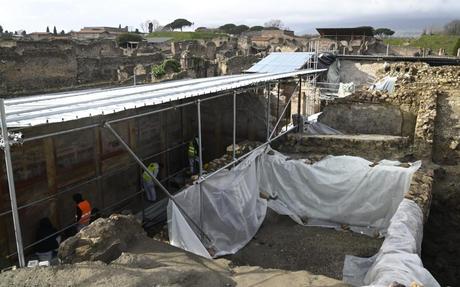

Restorers standing on scaffolding carefully scrape away the dust and dirt of centuries, revealing lavishly decorated walls. On the floor they expose beautifully preserved mosaics of colored marble.
The story continues
While digging, the Bourbon tunnellers used shards of old terracotta roof tiles to support the walls of the tunnel and prevent it from collapsing.
"I have never seen a Bourbon tunnel like this, nor the use of ceramic materials to strengthen the walls," says Dr. Sophie Hay, a British archaeologist who has worked in Pompeii for 20 years.
"It allows us to look at the history of the discovery of Pompeii, but also that of ancient Roman times. The tunnel builders were looking for the best, shiniest pieces to display in their palazzi."
Finely drawn images
Another tunnel pierced through another part of the enormous villa, damaging walls decorated with finely drawn images of leopards, griffins, deer and swans.
As workers picked their way through the layers of pumice and hardened ash that had settled 1,700 years earlier, they had no idea what they were destroying until it was too late.
It is believed that the property was owned by a Roman politician who apparently commanded a trading empire in Pompeii.
Attached to it is a bakery where slaves and mules turned enormous grinding stones in a dimly lit room that smelled of sweat and manure. Just a few meters from the giant grinding stones, archaeologists have found a latrine where slaves relieved themselves before returning to the hard work of grinding wheat for bread. They came from all over the empire, from Britain and Gaul to Syria and Judea.
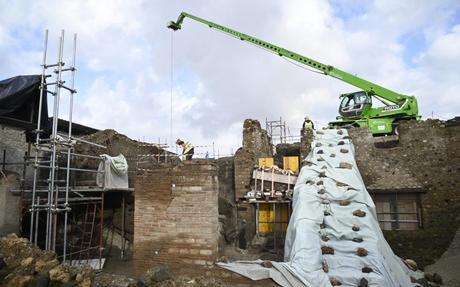
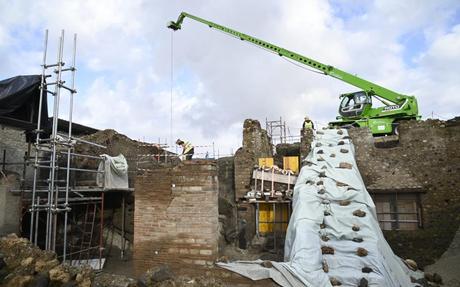
The tunnellers caused enormous damage to such rooms as they blindly dug deeper and deeper underground, crashing through walls and destroying parts of the fresco. In any case, they left the frescoes and mosaic floors intact because they were hunting for more valuable treasures.
"They were looking for precious objects such as statues or something made of bronze, silver or gold," said Raffaele Martinelli, an archaeologist who worked on the dig.
The Bourbons' legacy was not all bad, said Gabriel Zuchtriegel, director of Pompeii.
"Without the excavations of the Bourbons, Pompeii would not have come to light. It's hard to judge them. It is easy to say that they caused damage, but at that time there were no established methods and no professional archaeologists. Instead, they were largely architects or engineers working on behalf of the Bourbons. They made mistakes, but we learned from those mistakes."
The Bourbon tunnel diggers may be history, but there are still underground thieves looking for ancient treasures.
'Tombaroli'
In Italian they are known as "tombaroli" - grave robbers. They are mostly locals, whose houses are located on the outskirts of Pompeii and on a plot of land that still conceals Roman villas that have not yet been officially excavated.
"Today's grave hunters use exactly the same techniques as they did during the Bourbon period," Dr. Russo said. "It's a big problem everywhere in the Pompeii region. They dig tunnels under their homes or gardens, making them very difficult to detect. You can't see them."
In 2019, authorities discovered an illegal tunnel leading from beneath a modern house on the outskirts of Pompeii to the remains of a large rural villa in an area known as Civita Giuliana.
While exploring the illegal dig, they came across an extraordinary find: an ancient Roman chariot with elaborate silver and bronze decorations and a stable containing the remains of three horses. The chariot was known in Latin as a 'pilentum', a carriage used for ceremonies such as escorting a bride to her new home.
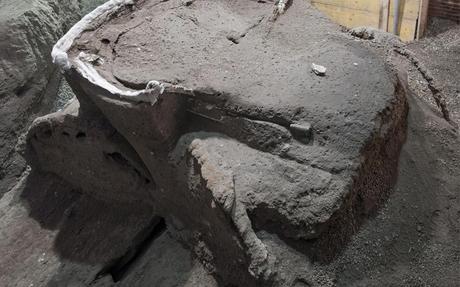
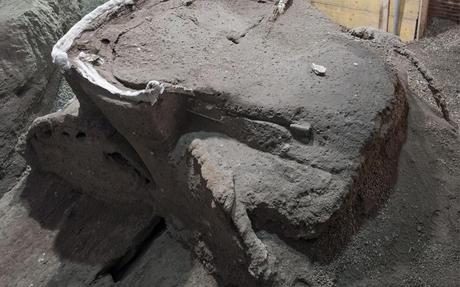
"It's difficult to fight the grave robbers because they operate in a very large area," Dr. Russo said. "The good news is that it has become harder for them to sell what they find - there are much stricter controls on the trade in artefacts."
